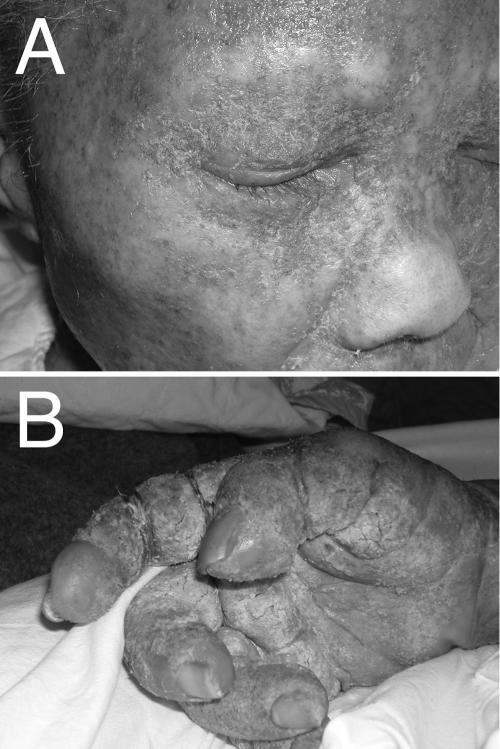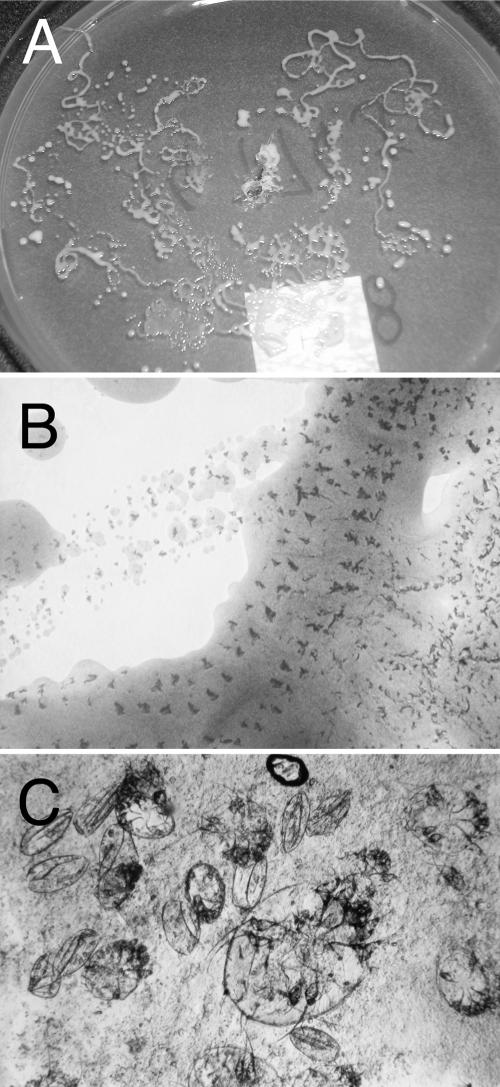Abstract
The diagnosis of Norwegian scabies was missed for a year for an elderly long-term-care facility resident. Serpiginous tracks were noted on the surface of Sabouraud dextrose agar used for fungal culture of the skin scrapings. This unusual laboratory manifestation must alert clinical microbiologists to the possible diagnosis of scabies.
CASE REPORTS
An 86-year-old woman was admitted from a nursing home to our hospital in August 2003 for her chronic, extensive skin problem. She had multiple underlying medical problems, including hypertension, congestive heart failure, diabetes mellitus, multiple past cerebrovascular accidents and dementia, and was bed bound. Her skin disease started about 1 year prior to admission and was initially diagnosed by general practitioners as eczema and psoriasis. Topical treatments with fluocinolone, betamethasone-clotrimazole-gentamicin cream, crotamiton, fusidic acid, and Polytar soap had been unsuccessful. The skin condition had deteriorated rapidly 1 month prior to admission. On admission, there was an extensive generalized hyperkeratotic lesion affecting the whole body including the face (Fig. 1A). The lesions were especially severe over the distal extremities, with cracked and weeping skin found over the hands and feet (Fig. 1B). An initial diagnosis of dermatomycosis was made by the attending doctor, who sent skin scrapings only for fungal culture. After overnight incubation of the Sabouraud dextrose agar at 37°C, serpiginous tracks were noted on the surface of the agar (Fig. 2A). Stereomicroscopic examination showed the presence of parallel tracks with two rows of footprints on each side (Fig. 2B). The findings suggested that the tracks were imprinted by an arthropod, followed by bacterial growth along the tracks. The skin scrapings were retrieved and examined microscopically in a drop of 10% potassium hydroxide, which revealed large numbers of Sarcoptes scabiei mites (Fig. 2C), and a diagnosis of Norwegian scabies was thus made. The patient was treated with repeated doses of topical 25% benzyl benzoate emulsion for 4 weeks with meticulous scrubbing and cleansing of the skin. This resulted in complete resolution of the skin infestation 4 weeks later (Fig. 3). The diagnosis of scabies in this patient prompted further examination of other residents in the nursing home. More residents were subsequently found to be infested by scabies as well, and all received topical benzyl benzoate treatment.
FIG. 1.
Clinical pictures of patient suffering from Norwegian scabies. Skin lesions on the face (A) and hands (B) of the patient.
FIG. 2.
Laboratory findings in Norwegian scabies. (A) Serpiginous tracks on Sabouraud dextrose agar caused by bacterial overgrowth after overnight incubation. (B) Stereomicroscopic examination of the tracks left by Sarcoptes scabiei on agar surface; the tracks consisted of parallel lanes of imprints, two on each side, representing the four pairs of legs of the adult mite (magnification, ×42.6). (C) S. scabiei mites in potassium hydroxide wet mount of the skin scrapings (magnification, ×28.4).
FIG. 3.
Skin of the patient after 4 weeks of daily application of 25% benzyl benzoate, showing complete resolution of the lesions.
Scabies is a common ectoparasitic infestation among residents of long-term-care facilities, and outbreaks in nursing homes, day care centers, hospitals, or other institutions are not uncommon (13). It is also one of the commonest hospital-acquired ectoparasitic infestations which affect both health-care workers and patients. Uncomplicated scabies is generally associated with a small ectoparasite load, and relatively prolonged and close contact is necessary for person-to-person transmission to occur. It has been estimated that a patient with conventional scabies harbors less than 15 S. scabiei mites, and 15 to 20 min of close contact is required for actual transfer of the mites from one person to another (12). On the other hand, immunocompromised and debilitated individuals, such as patients infected by the human immunodeficiency virus, those suffering from hematological malignancies, transplant recipients, patients receiving long-term corticosteroid therapy, those affected by Down's syndrome or leprosy, and the elderly, may develop Norwegian or crusted scabies (11). Compared to conventional scabies, Norwegian scabies is an extremely infectious condition, since tens of thousands of mites are present in the hyperkeratotic skin and squames of the patients. Early diagnosis of Norwegian scabies is thus crucial for therapeutic and infection control purposes.
The laboratory diagnosis of scabies is simple, and treatment is relatively straightforward, despite the fact that patients suffering from Norwegian scabies require a more prolonged course of therapy. Unfortunately, the diagnosis of scabies is often missed initially, especially by nonspecialists. Standard dermatology texts would quote pityriasis rosea, tinea versicolor, pediculosis corporis, and lichen planus as possible differential diagnoses of scabies. Yet it is well known that scabies may also be mistaken initially for other dermatological or systemic conditions, such as drug reactions, psoriasis, systemic lupus erythematosus, and bullous pemphigoid (1, 6, 8). Prior use of topical corticosteroids may alter the appearance of the scabious lesions—a condition known as scabies incognito—thus further obscuring the clinical diagnosis (8). Pruritus in elderly people may be attributed to “senile pruritus” or underlying diseases, and atypical presentations of scabies in this group of patients may further confuse or delay the diagnosis. Inappropriate long-term application of potent topical steroids, as seen in this case, may then lead to the formation of Norwegian scabies (3). Clinicians therefore must be aware of the possible manifestations of scabies, including cases where the head and neck are involved. Uncomplicated scabies in adults is typically described as a skin condition with sparing of the head and neck region; the presence of lesions in the head and neck may therefore divert the clinician's suspicion to other skin problems. One should, however, note that head and neck involvement could also occur in infants and immunosuppressed individuals. The history of prior use of topical steroids should be taken into account, which might alter the clinical manifestations of the disease. Epidemiological clues that might suggest scabies include patients' residence in nursing homes and similar symptoms in other household members or residents and staff of long-term-care facilities, since an isolated case in such settings is considered uncommon.
The presence of serpiginous tracks on microbiological agars as an incidental finding in scabies has never been reported, although their migration on agars has been used for in vitro determination of acaricide activities (2). The condition is reminiscent of the agar plate culture technique in the recovery of Strongyloides stercoralis larvae from stool (9). Such a dramatic phenomenon is likely to be present only in skin specimens from patients with Norwegian scabies in which a large number of mites are present. It may not be important in the immediate diagnosis of scabies, because tracks can only be seen after overnight incubation. However, since scabies might sometimes be misdiagnosed initially as dermatomycosis, skin scrapings may be sent only for fungal culture rather than for parasitological examinations. Such unexpected findings must alert the clinical microbiologist to the possibility of a missed case of scabies. Examination of the tracks under a stereomicroscope should reveal the presence of unmistakable parallel tracks made by the footprints of the mites (Fig. 2B). Such marks imprinted by the legs of the arthropod will not be seen on microscopic examination of the furrows made by Strongyloides stercoralis larvae on agar surface. Mites may occasionally contaminate fungal cultures, resulting in changes of fungal morphology or tracks on the agar plates (5). Reexamination of the skin scrapings should be able to confirm the diagnosis of scabies or contaminant mites.
Uncomplicated scabies can readily be treated by a number of acaricides (3). Twenty to 25% benzyl benzoate is an effective and inexpensive treatment. A single overnight application is effective in most cases, but a second application 2 to 7 days later is usually advisable. Ten percent crotamiton cream may be used, but five daily applications are needed, and it has a lower cure rate of only 50 to 60%. Lindane should be avoided in infants and young children because of potential neurotoxicity. Five percent permethrin cream and 5% malathion lotion have excellent activities on Sarcoptes scabiei. Other options include 6 to 10% sulfur in petrolatum and topical or oral ivermectin. Although similar agents may be used for the treatment Norwegian scabies, the management of these patients is more problematic. Of primary importance is the necessity for strict contact precautions during the period of hospitalization. Repeated applications of acaricides are necessary to ensure killing of the mites. Some agents, such as lindane, are contraindicated because of the possibility of neurotoxicity following repeated use. Keratolytic agents, such as 5 to 10% salicylic acid in petrolatum or 40% urea, may be used to facilitate removal of the hyperkeratotic skin and penetration of acaricides. Weekly topical permethrin for 6 weeks has also been used for the treatment of Norwegian scabies. Ivermectin has been used successfully for the treatment and control of scabies (7, 10), including the treatment of Norwegian scabies. An initial dose of 200 μg/kg ivermectin is usually given, followed by doses of 200 μg/kg repeated every 1 to 2 weeks to a total of two to three doses. However, clinical and in vitro resistance to ivermectin has been described recently (4), and more-judicious use of this valuable agent, together with more-vigorous control of scabies in the community, is therefore necessary.
REFERENCES
- 1.Almond, D. S., C. J. Green, D. M. Geurin, and S. Evans. 2000. Norwegian scabies misdiagnosed as an adverse drug reaction. Br. Med. J. 320:35-36. [DOI] [PMC free article] [PubMed] [Google Scholar]
- 2.Brimer, L., L. Bonlokke, C. Pontoppidan, S. A. Henriksen, N. Gyrd-Hansen, and F. Rasmussen. 1995. A method for in vitro determination of the acaricidal effect of ivermectin using Sarcoptes scabiei var. suis as test organism. Vet. Parasitol. 59:249-255. [DOI] [PubMed] [Google Scholar]
- 3.Chosidow, O. 2000. Scabies and pediculosis. Lancet 355:819-826. [DOI] [PubMed] [Google Scholar]
- 4.Currie, B. J., P. Harumal, M. McKinnon, and S. F. Walton. 2004. First documentation of in vivo and in vitro ivermectin resistance in Sarcoptes scabiei. Clin. Infect. Dis. 39:e8-e12. [DOI] [PubMed] [Google Scholar]
- 5.Duek, L., G. Kaufman, E. Palevsky, and I. Berdicevsky. 2001. Mites in fungal cultures. Mycoses 44:390-394. [DOI] [PubMed] [Google Scholar]
- 6.Gach, J. E., and A. Heagerty. 2000. Crusted scabies looking like psoriasis. Lancet 356:650. [DOI] [PubMed] [Google Scholar]
- 7.Huffam, S. E., and B. J. Currie. 2002. Ivermectin for Sarcoptes scabiei hyperinfestation. Int. J. Infect. Dis. 2:152-154. [DOI] [PubMed] [Google Scholar]
- 8.Kim, K. J., K. H. Roh, J. H. Choi, K. J. Sung, K. C. Moon, and J. K. Koh. 2002. Scabies incognito presenting as urticaria pigmentosa in an infant. Pediatr. Dermatol. 19:409-411. [DOI] [PubMed] [Google Scholar]
- 9.Koga, K., S. Kasuya, C. Khamboonruang, K. Sukhavat, M. Ieda, N. Takatsuka, K. Kita, and H. Ohtomo. 1991. A modified agar plate method for detection of Strongyloides stercoralis. Am. J. Trop. Med. Hyg. 45:518-521. [DOI] [PubMed] [Google Scholar]
- 10.Meinking, T. L., D. Taplin, J. L. Hermida, R. Pardo, and F. A. Kerdel. 1995. The treatment of scabies with ivermectin. N. Engl. J. Med. 333:26-30. [DOI] [PubMed] [Google Scholar]
- 11.Sargent, S. J. 2004. Ectoparasites, p. 755-763. In C. G. Mayhall (ed.), Hospital epidemiology and infection control. Lippincott Williams & Wilkins, Philadelphia, Pa.
- 12.Service, M. W. 1996. Medical entomology for students. Chapman & Hall, London, United Kingdom.
- 13.Strausbaugh, L. J., S. R. Sukumar, and C. L. Joseph. 2003. Infectious disease outbreaks in nursing homes: an unappreciated hazard for frail elderly persons. Clin. Infect. Dis. 36:870-876. [DOI] [PubMed] [Google Scholar]





